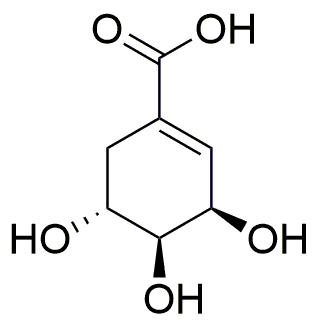Shikimic acid is widely utilized in research focused on
- Pharmaceutical Development: It serves as a key precursor in the synthesis of antiviral drugs, particularly oseltamivir (Tamiflu), which is used to treat influenza. This application is crucial for public health, especially during flu outbreaks.
- Herbal Medicine: Found in several medicinal plants, shikimic acid is studied for its potential health benefits, including anti-inflammatory and antioxidant properties, making it valuable in traditional and modern herbal remedies.
- Biotechnology: It plays a role in metabolic engineering, where researchers utilize it to enhance the production of valuable compounds in microorganisms, benefiting industries like biofuels and bioplastics.
- Agriculture: Shikimic acid is being explored as a natural herbicide, offering an environmentally friendly alternative to synthetic herbicides, which can help reduce chemical runoff and promote sustainable farming practices.
- Food Industry: Its application in food preservation and flavor enhancement is being researched, as it may contribute to the development of natural preservatives that extend shelf life without compromising safety.
General Information
Properties
Safety and Regulations
Applications
Shikimic acid is widely utilized in research focused on
- Pharmaceutical Development: It serves as a key precursor in the synthesis of antiviral drugs, particularly oseltamivir (Tamiflu), which is used to treat influenza. This application is crucial for public health, especially during flu outbreaks.
- Herbal Medicine: Found in several medicinal plants, shikimic acid is studied for its potential health benefits, including anti-inflammatory and antioxidant properties, making it valuable in traditional and modern herbal remedies.
- Biotechnology: It plays a role in metabolic engineering, where researchers utilize it to enhance the production of valuable compounds in microorganisms, benefiting industries like biofuels and bioplastics.
- Agriculture: Shikimic acid is being explored as a natural herbicide, offering an environmentally friendly alternative to synthetic herbicides, which can help reduce chemical runoff and promote sustainable farming practices.
- Food Industry: Its application in food preservation and flavor enhancement is being researched, as it may contribute to the development of natural preservatives that extend shelf life without compromising safety.
Documents
Safety Data Sheets (SDS)
The SDS provides comprehensive safety information on handling, storage, and disposal of the product.
Product Specification (PS)
The PS provides a comprehensive breakdown of the product’s properties, including chemical composition, physical state, purity, and storage requirements. It also details acceptable quality ranges and the product's intended applications.
Certificates of Analysis (COA)
Search for Certificates of Analysis (COA) by entering the products Lot Number. Lot and Batch Numbers can be found on a product’s label following the words ‘Lot’ or ‘Batch’.
*Catalog Number
*Lot Number
Certificates Of Origin (COO)
This COO confirms the country where the product was manufactured, and also details the materials and components used in it and whether it is derived from natural, synthetic, or other specific sources. This certificate may be required for customs, trade, and regulatory compliance.
*Catalog Number
*Lot Number
Safety Data Sheets (SDS)
The SDS provides comprehensive safety information on handling, storage, and disposal of the product.
DownloadProduct Specification (PS)
The PS provides a comprehensive breakdown of the product’s properties, including chemical composition, physical state, purity, and storage requirements. It also details acceptable quality ranges and the product's intended applications.
DownloadCertificates of Analysis (COA)
Search for Certificates of Analysis (COA) by entering the products Lot Number. Lot and Batch Numbers can be found on a product’s label following the words ‘Lot’ or ‘Batch’.
*Catalog Number
*Lot Number
Certificates Of Origin (COO)
This COO confirms the country where the product was manufactured, and also details the materials and components used in it and whether it is derived from natural, synthetic, or other specific sources. This certificate may be required for customs, trade, and regulatory compliance.


